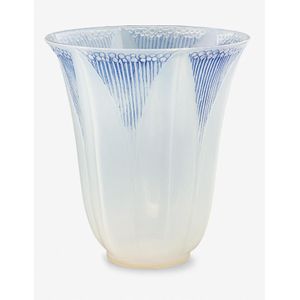Rene Lalique Guirlandes Vase, 1935 Design
You must be a subscriber, and be logged in to view price and dealer details.
Subscribe Now to view actual auction price for this item
When you subscribe, you have the option of setting the currency in which to display prices to $Au, $US, $NZ or Stg.
- Etched - Glass decorated with an etched design, which is achieved through marking out the pattern, protecting the area that is not be etched, and then immersing the object in acid to dissolve the surface of the unprotected area. With some glass objects, such as cameo glass, there may be several layers of different coloured glass, and part of the top layer is dissolved leaving the bottom layer as the background. The longer the time of exposure of the object to acid, the deeper the etching.
The word etching is also sometimes used to describe another method of decoration, where wheel grinders were used decorate the surface, but this technique is usually known as engraving. - Patination / Patina - In broad terms, patination refers to the exterior surface appearance of the timber, the effect of fading caused by exposure to sunlight and air over the course of a century or more, changing the piece to a soft, mellow colour.
As patina is very difficult to replicate, it is one of the most important guides to determining the age of furniture.
Patina is also the term applied to the bloom or film found on old bronzes due to oxidisation. - Acid Etched - Acid etching is often used on glass, metals, and stone to create decorative finishes or to prepare the surface for further treatment or coating. The process of acid etching involves applying an acidic solution, such as hydrochloric acid or nitric acid, to the surface of the material and allowing it to react with the surface. The acid etches away a thin layer of the material, creating a rough, uneven finish. Acid etching can be used to create a variety of different finishes, from a subtle matte finish to a more pronounced, textured finish.
- Floral Swag / Garland / Festoon - Floral swags are a decorative motif often used in the ornamentation of various objects, such as silverware, glassware, and furniture. The term "swag" refers to a garland or wreath of flowers, foliage, or other decorative elements, which is usually arranged in a loop or curve.
Floral swags can be found in a variety of decorative styles, from ornate Baroque and Rococo designs to more naturalistic Art Nouveau and Art Deco styles. They are often used to add a touch of elegance, refinement, or whimsy to an object, and can be seen on a range of items from chandeliers and candlesticks to picture frames and tea sets.
In the decoration of silver objects, floral swags are often used to accentuate the curves and lines of the piece, and to add visual interest to the surface. Similarly, on glass objects, floral swags may be used to frame or highlight a particular area of the object, or to add a touch of color and delicacy.
On furniture, floral swags can be found on a variety of pieces, from cabinets and armoires to chairs and sofas. They are often used to enhance the lines and curves of the furniture, and can be used to create a sense of movement and flow in the design.
Overall, floral swags are a versatile decorative element that can be adapted to a range of styles and applications, and have been used in the decoration of various objects throughout history.
This item has been included into following indexes:
-
Lalique (France), item types
- other items 1,054
- vases 536
- Lalique (France), patterns, vases - Guirlandes 2
- Schneider / Le Verre Francais (France) - lamps and lighting 301
Visually similar items

A Rene Lalique Guirlandes vase, designed 1935, the tapering cylindrical body moulded with entwined tinsel garlands, in frosted and clear glass with a blue patina, acid etched R. Lalique France, 21 cm high. Provenance: All Chenil Gallery, Chelsea, Mr Hans M

A Rene Lalique Damiers vase, designed 1935, the flared cylindrical body moulded with a repeating pattern reminiscent of a chequerboard, in frosted and clear glass with a grey patina, acid etched R. Lalique France, 23.5 cm high. Provenance: Mr Hans Mueller

A Rene Lalique opalescent and blue stained glass vase, in the Cytise pattern, tapering conical shape on slightly spreading foot, the walls moulded with seven encircling chevron ribs. Etched mark R. Lalique, France'. Height 12.7 cm

Rene Lalique, Campnanule', opalescent glass vase, R Lalique impressed mark to the base. Height 15 cm
